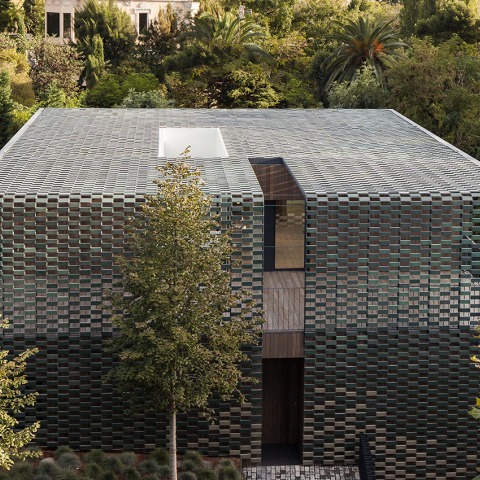Description of the project by PMMT
Innovation and functionality are the binomial that characterize one of the newest works of PMMT, a Catalan architecture firm that just concluded the TR House in Barcelona. Built on a site that presents an accentuated topography and where it already existed an historical house surrounded by a spacious garden area, the new house had to obey to the dimensions defined by the urban planning regulations, while at the same time it should be able to integrate itself with the landscape and functionally adapt to the client’s needs.
The result is a 13,00m x 13,50m three-storey volume that overturns all of its rooms in the opposite direction of the main facade, in order to be able to achieve privacy and function features demanded by the client. Meanwhile, the other facades are wrapped with a green vitrified ceramic skin that camouflages the house with its verdant surroundings.
TR House Barcelona is a single-family house with a compact morphology. Its shape is the answer to the limitations presented by the pre-existing conditions, combined with an innovative solution and with solid functionality criteria. In light of the urban planning constrains of this site and once it is situated on a depressed area, we had to solve an accentuated slope between the main entrance and the access to the house, creating two levels of access; one inferior and one intermediate. Trough slopes and ramps that establish different relations between the landscape, the house and its interiors, we’ve tried to minimize the big impact of the gap between the main entrance and the lower part of the site.
The result is a 13,00m x 13,50m three-storey cube-shaped volume, placed on a lower level than the street, that tries to establish a visual relationship with the creek that delimits the site, at the same time as it integrates itself visually with the landscape and with the surrounding higher buildings. The volume is organized in a way that gives response to the users’ needs, creating a central axis from which you can access the several rooms and that guarantees, at the same time, privacy from the street and neighbours, and a visual relationship with the natural environment. In the opposite direction of this axis, the house seeks to merge with the verdant surroundings.
The house is structured around a central patio that articulates all the rooms with the perimeter corridor that surrounds it at the same time as it connects the different floors with a stair also located around the same patio. The existence of this central area allows the entrance of day light as well as it creates an interesting game of crossed visual perspectives from one room to another. The lower floor is occupied with the “day areas”, such as the living and dining room and the service areas. As for the “night areas” - bedrooms and correspondent bathrooms - are situated on the middle floor. The top and third floor is occupied by an office area, a guest room and an outside terrace covered by a pergola.
The image of the building aims to respond to the defined functional needs. On one side, an outer envelope made of vitrified ceramic tiles, assembled on a stainless steel wired net, giving response to the need to merge with the green surroundings. Within a range of greens, we’ve worked with four different tones to obtain de same shades that one observes on the surrounding landscape during the four seasons of the year, creating the required merging feeling. By this ceramic curtain we were able to solve 4 plans that in architecture are normally solved in separate ways: the facade, the pergola, the curtain walls and the roof.
On the other side, the facades where all the rooms are open to, respond to visual and privacy settings, which connect or hide the inhabitants with the surroundings. The resulting solution is a facade created with chestnut wooden slats, which have openings that where strictly dimensioned according to lighting needs and comfort of the users. In these opening areas one can find a hidden system of adjustable horizontal aluminium slats that allow the user to control solar incidence and to provide greater comfort levels.
The outside platforms are stitched in a way that connects the different access areas located different heights, with a cobblestone ramp made with granite pieces interpolated with small grass areas.
On the exterior side that is open to the landscape, a large wooden platform has de function to lengthen the living/dining room area, extending it to the outside, creating a nice outer living space, under the shade of trees. This platform also gives access to the back part of the house, establishing an interesting circuit flow.
Due to its morphology and topography, the trapezium shaped site exposes a heavy slope on the tip that is closer to the creek. In this area, further away from the street, a playing area is generated. The pronounced slope is solved with a wooden platform sequence that establishes a dialogue between the house and the garden, once the platforms are made with the same type of chestnut wood that one can find on the façade. The proportion and disposition of the wooden pieces are the same, both on the facade and on the exterior platforms.
Therefore, the TR House Barcelona represents an innovative fully-functional exercise that achieves a clear dialogue with its surroundings at the time as it gives an answer to the changing needs of its users.














































